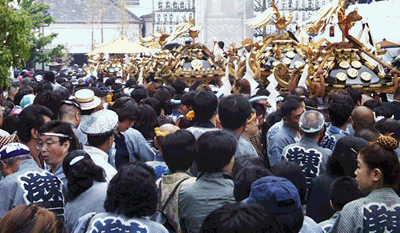
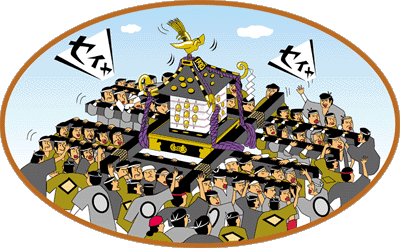
The wildest and the most boisterous days in Asakusa ended. Sanja Festival is one of the most famous festivals in Japan.
The very first feature of Asakusa-e.com on web is a realistic report on Sanja Festival taking advantage of being located right in Asakusa.
Send us what you did and saw at the festival, or thought of our report.
Sanja Festival having been the wildest, the liveliest festival in all Japan, it is sung in one of kiyomoto, a traditional song.
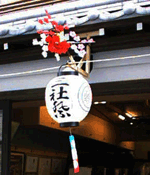
One of the paper lanterns hanging along the eaves of the houses |
The wildest and the most boisterous days in Asakusa ended. Sanja Festival is one of the most famous festivals in Tokyo. The very first feature of Asakusa-e.com on web is a realistic report on Sanja Festival taking advantage of being located right in Asakusa. |
|
Sanja Festival is a nation wide famous festival of Asakusa Shrine which enshrines the three sacred men that played important roles in foundation of Sensoji Temple. They are called Sanja-sama and worshiped as much as Kannon in Sensoji Temple, and the festival is dedicated to these three. The main festivity of the festival used to be a procession of elaborately decorated floats in Edo era, but nowadays parade of mikoshis, the portable shrines is what the festival is famous for. |
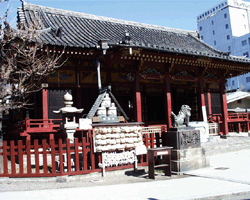
Asakusa Shrine |
|
44 blocks of the residential area of its worshippers parade with their mikoshis for three days and whole Asakusa district gets wild. On the last day, the three main mikoshis of Asakusa Shrine symbolizing the three sacred men march to pay visit and bestow blessing to every 44 blocks divided into three groups. The blocks names and their division follow the traditional names and division which shows the typical persistence of people living in Asakusa. The Festival is held on the third weekend of every May, and 17, 18, 19 were the day in 2002. JIDAIYA locates in Asakusa 3-chome that is at the back of Kannon house but referred to the old division, the office is in Kisakata 1-chome, Kisa-ichi block, and the shop in Umado 2-chome, Uma-ni block. Since the office was settled before the shop, we participate in the festival as the members of Kisa-ichi block. |
|
|
The block is named after Lord Kisakata of Akita Domain who spent his alternate-year attendance here. As Asakusa becomes a thriving area of Tokyo, geisha houses started to gather in Kisakata, and Kisa-ichi block became a famous for area for geishas. Kisa-ichi block is a traditional area for Japanese entertainment. You can find a stone monument for a theater named Miyakoza, also. There are not as much geisha houses as it used to be, but you can still see geishas going in and out of geisha houses and Japanese-style restaurants where they entertain the diners. Especially at the time of Sanja Festival, you can hear the festival music in streets lined with traditional Japanese restaurants. The sight of geishas strolling in their best kimonos by the side of mettlesome young men bearing mikoshi in matching happi coats is particular to Kisa-ichi block, and it is just what was seen 100 years ago. |
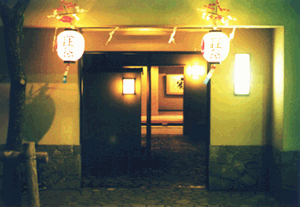
In front of a Japanese-style restaurant |
Now to the typical Japanese festival of Sanja Festival of Kisa-ichi block!
| May 17 Fri. Cloudy |
| 1:00PM Procession of Daimyos |
|
Everybody assembled at the libation offering house of the block on Yanagi -dori, the main street in Kisa-ichi block and started the parade at 1 PM. Led by Shinmon men with iron clubs, Ayame-ren proceed playing festival music, followed by the groups chanting a ceremonial hymn or performing special dances and art. They are the curtain raisers of Sanja Festival. Although Sanja Festival is regarded to be a performance of vitality, these festivities keep the solemnity and the godliness of the festival. Any one would be attracted by the sight of sophisticated Ayame-ren on floats, cool steeple jacks, and elegant geishas in a ceremonious formality, and on seeing them bring us back the excitement of the past Sanja Festivals. |
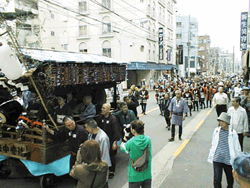
|

|
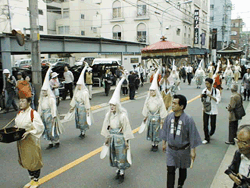
|
| Float of festival music players and steeple jacks | Geishas | Shirasagi no mai |
| 7PM-9PM Parade of mikoshi through the block | |
|
Parade of mikoshi is what everybody in Asakusa had waited for a year, and the bearers seem to be contented. With less members than the rest of days of the festival, most of the bearers are familiar with each other and they are proud to be born and grew up in Asakusa. They are the ones who gather to bear mikoshi from the very first day of the festival every year. The directors of the parade are the youth group of the block community. They are the ones who themselves, in truth, are eager to bear mikoshi but they stay in background, doing every other work to carry out the parade safely and enjoyable, leading the way, handling the crowd, and cheering to boost the festival. They show superb unity and leadership and that is a tradition which had been passed on to the group each year. The former members of the youth group wear light green happi coats, the present members brown, and others grayish blue, with the designed letters of Kisa-ichi dyed on the back. No one is allowed to bear mikoshi without wearing one of these happi coats and Kisa-ichi block outnumbers other blocks in the number of the members wearing them. |
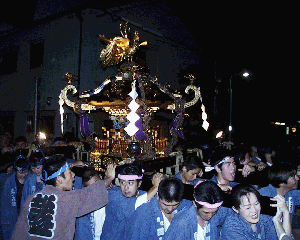
Night Parade of Mikoshi |
|
We marched through the block for 2 hours and finished at the libation offering house. The parade is supposed to be just a warm-up for the climax, but everyone was already excited enough. Late at night, the sound of the rainfall was heard on the roof. Well, nothing can stop us now, whatever may it fall. |
|
| May 20 Sat. | |
|
Today is the day of Rengo Togyo.
88 mikoshis from each 44 blocks including children's mikoshi assemble in the yard of Sensoji Temple to receive special purification service one by one. Around 11PM mikoshis of each block head for Sensoji Temple through Yanagi Dori one after the other. Every mikoshi of the block north to Sensoji Temple pass through Kisa-ichi block and our block is just like an exhibition site of mikoshis in unique styles and various designs of the happi coats. They marched in rain proudly in honor of their own block. |
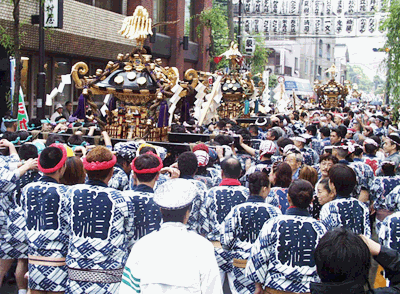
Just like an exhibition of mikoshis |
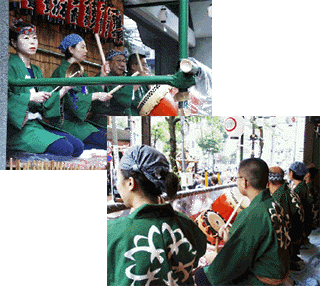
Festival music players |
A festival and music always go together. Mochizuki school of traditional accompaniment music plays for Kisa-ichi mikoshi and its bearers at the starting point on Yanagi-dori. On hearing the cheering music, attachment to the hometown and the Japanese culture upsurge in participants' hearts. They play for all three days every time our mikoshi passes, and the bearers are all thankful. |
|
12:30 It is our turn to start off at last. Mikoshi marched off in the showering rain directed by the youth group members, with the festival music, and joined other 86 mikoshis and their groups of bearers and several ten thousand audiences behind the Hondo of Sensoji Temple.
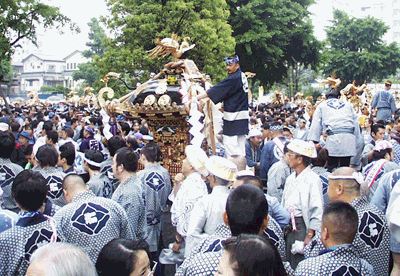
|
| 1PM Start of Rengo Togyo | |
| The block names are called one by one and the mikoshi is carried to Asakusa Shrine located in the precincts of Sensoji Temple. | |
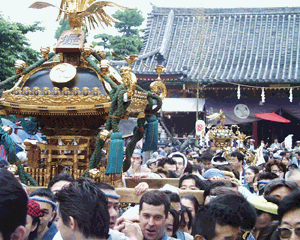
After the purification service |
Since the rite of purification is done one by one, we had to wait for almost an hour. Just at our turn, it started to rain harder just as if deities of Sanja trying to play a joke on us. While being witnessed by the representatives of the block, committee members, and the guests, mikoshi proceed to the main hall of the shrine, and at the sound of a whistle by the leader of the youth group member, it is pushed up high to show respect to Sanja deities. This is one of the most exciting and soul-stirring moment of Sanja Festival. No one cares the hard rain, and wispy cloud of steam arises by the fervor of the bearers. After the service, mikoshis parade back to the libation offering house while young children's mikoshi and the drum float proceed through the block. |
|
Even the young children are in full uniform for the festival in Asakusa. Every photographer is attracted by the way they toddle, holding on to a string on the float. This way, children born in Asakusa take part in the festival while they are in diapers, come to long for the festival to come, bear children's mikoshi and then the adults' regular mikoshi, manage and lead Sanja Festival in 10 or 20 years in future. The members of the youth group direct children's mikoshi, too. They are the hardest workers at the festival.
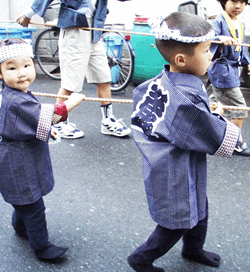
|
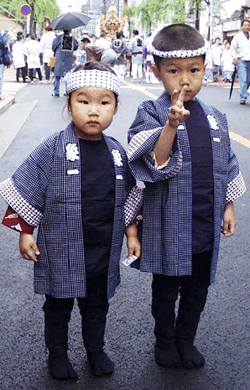
Children pulling the float |
| 3PM The parade of mikoshi through the block | |
|
Half of the schedule of the festival has finished. Mikoshi marched off for the parade through the block with less bearers than usual year. Although everyone is quite worn out from the Rengo Togyo in the morning, the cheering by the youth section stir the spirit of Asakusa in our blood. When rhythmical shouting for mikoshi-bearing is heard through the block, the bearers increase in number and at the end, all went wild. |
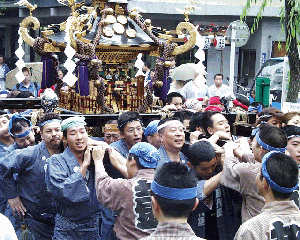
Mikoshi parading through the block |
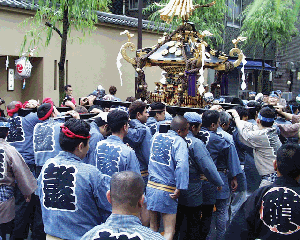
Mikoshi parading |
The bearers are not always locals of the block. To bear mikoshi of Sanja Festival is considered to be a great honor, and mikoshi lovers come from all over Japan, tapping into the network of local residents, and asking for extra happi coat. The name of the shop or the family is dyed on the collar of the happi coat, and the coat identifies the person wearing it. Once you wear the same happi coat, it doesn't matter whether you are brought up in Asakusa or not. The coat bonds anyone wearing it. |
|
Now the lottery is held to choose the bearer of Miyadashi the bearer of the main mikoshi on which the three deities visit each community block. It is the greatest honor to bear one of the main mikoshi, and you must win a lottery in order to take part. Only 70 members are chosen from each block, and Kisa-ichi block limits candidates to males, because of not only paying respect to the tradition, but considering the boisterousness of the parade. The four members of the staff of JIDAIYA won the lottery. And there follow a series of effort taking task to bear the main mikoshi . One cannot participate in just winning the lottery. They must go to the libation offering house at around 3 in the next morning to exchange the winning ticket to a certificate emblem. |
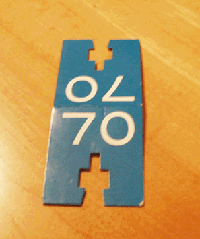 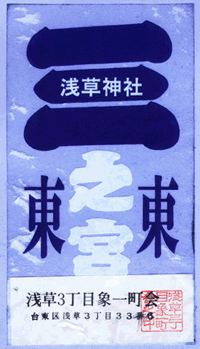
Winning ticket & certificate emblem |
| 6PM - 8:30PM Mikoshi parading through the block | |
|
The rain didn't seem to stop but amazing number of people assembled to join the parade. We shouted and swayed, zigzagged down the streets, pushing mikoshi up and down, and the beer after the parade tasted just great! Because there are a lot of restaurants and bars in Kisa-ichi block, bottles of beer and sake and some food to go with are offered by various restaurants in Kisa-ichi block at the intermissions of the parade, four times each, for three days. We are all so thankful of their generousness. Everybody goes home exhausted and still excited at the end of the second day of Sanja Festival. Being an entertainment area, Kisa-ichi block plays traditional Sanja Festival song in a style of singing sung by geishas. We go home but not to go to bed. We hold parties at home until late at night wishing to have a fine day the next day. |
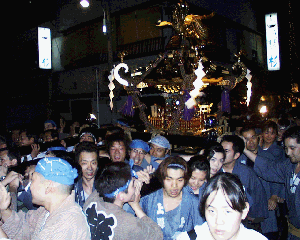
Night parade |
| May 19th,Sun. Cloudy with occational sunshine |
|
The rain had stopped and it seems to be a fine day today. This is the day of Miya Mikoshi. The bearers started off at 3 in the morning to get the certificate emblem and then assemble in the precinct of Sensoji Temple. The assembling place is barricaded and strictly guarded by policemen from intruders. All just wait for the start of Miyadashi at 6AM.
The bearers are not the only ones to wake up so early.
In the precinct of Asakusa Shrine, the three main mikoshis sit in line waiting to start the visit to the community and bestow the blessing. |
| 6AM - 8:50 AM | |
|
After the ceremonial hand clapping by nearly 10,000 bearers, three mikoshis were pushed up high vigorously, and surrounding bearers rushed to grab the bearing bar. They fought and clashed, while mikoshis swayed right to left over the crowd of people. Yells and fights filled the site and this explains why Sanja Festival is called Tokyo's Fighting Festival. Mikoshis managed to get out of the shrine precincts only to find full crowd of contestants in the front yard of Hondo. Mikoshis never seemed to move in the right direction, bearing bar slapped onto the ground time to time. Some of the bearers climbed up on mikoshi to take leadership, and that made mikoshi heavier and more difficult to handle. |
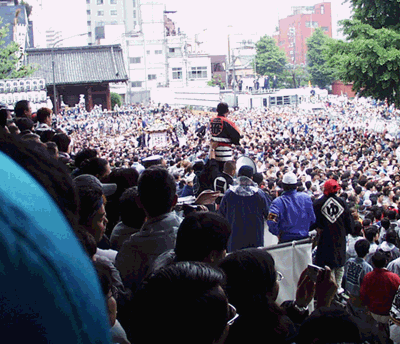
The leader of directors of the festival |
|
In the past, riot troops have tried to drag them down, but they failed to get even close to mikoshi. When the third mikoshi reached in the Hondo yard, mikoshis were pushed up high to show respect to Kannon and big applaud arose from the audiences. Around 7PM, San-no-miya got out of the temple precinct and headed for Tobu blocks where Kisa-ichi block locates. Our staff members were among the group. One of them managed to bear mikoshi but was dragged away in about 10 seconds, and the other could not even touch the bearing bar until they reach the Hondo yard. Usually Miya-dashi finishes before 8, but this year Ichi-no-miya and Ni-no-miya were not able to move anywhere from the Hondo yard making the leader impatient enough to climb up on the watch tower and direct himself. |
|
| Ichi-no-miya then managed to get out of the temple gate and headed for Nishibu block, but Ni-no-miya stayed in the yard swaying back and forth until nearly 9 o'clock. Almost three hours of fervent battle has finished at least. |
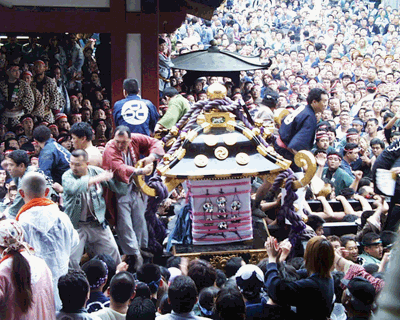
Ni-no-miya gridlocked in the Hondo yard
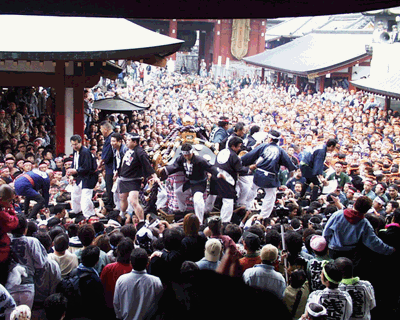
| 10:30AM & 2PM Inspection of Togyo by priest of Asakusa Shrine | |
|
Horse guards of Asakusa Shrine accompany the three main mikoshis paying visit to each block simultaneously while the priest inspect the visit in order. JIDAIYA received the honor to serve with one of our rickshaw as his transportation device. Four members including rickshaw men and the guards served. Two of them were the ones participated in Miyadashi. They were quite nervous to serve such an important role, but have managed to accomplish the task safely. The inspection was held once in the morning and in the afternoon, for two hours each. The combination of the parade of mikoshi and rickshaw created very traditional atmosphere. |
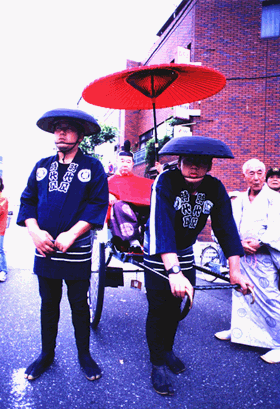
Rickshaw for the inspection of the shrine priest |
| 10AM & 1PM Parade through the block | |
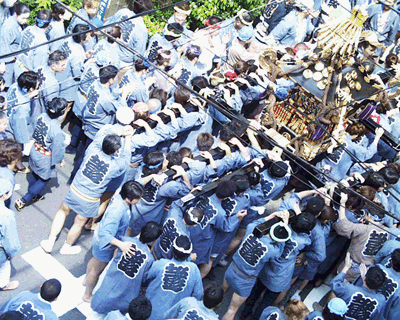
Mikoshi of the block |
Before the arrival of San-no-miya at around 5 o'clock, local mikoshi parade was done twice at 10AM and 1PM. More bearers than yesterday got together and marched lively. Under the clear sky, the area was filled with happy atmosphere with the sound of festival music and a crowd of people. And Miya Mikoshi was what everyone was waiting for. |
| 4PM Bearers assemble | |
|
The visit of Miya Mikoshi is the climax of the festival. This year, San-no-miya will pay a visit and will be passed on from the bearers of Kisakata to Kisa-ichi bearers. People wearing identical happi coats appear from here and there far more in number than the local parade. Young and old, men and women, they are all thrilled to welcome Miya Mikoshi, and the members of the youth group are already eager to direct the parade. |
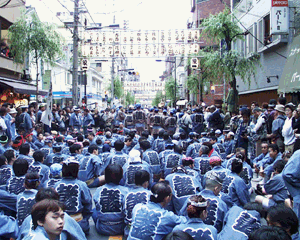
Bearers waiting for San-no-miya |
| 4:50PM San-no-miya arrives at Kisa-ichi block | |
|
Finally San-no-miya arrived to be passed on to Kisa-ichi bearers.
After the ceremony of Kisakata block of hand clapping to close their parade and thank deity for his regard, it was our turn to bear San-no-miya. At the go sign by the youth group member, everyone rushed to Mikoshi. Crowd of bearers surround San-no-miya in thick stratum and just then, it started to rain heavily. It seemed like a friendly message from the deity that it rained at our turn at Rengo Togyo when we received the purification service and now when its our turn to bear.
As soon as the opening ceremony of clapping hands and clicking the wood blocks finishes, San-no-miya was brought up high, and with rhythmical shouts of "Soi-ya, soi-ya".
The festival music had reached its climax and mikoshi parade proceeded like a kind of living thing with a will, swelling and rolling with a swarm of people.
When the passing-on spot of Uma-ni block drew near, those who succeeded in bearing mikoshi tried to hang on to the bearing bar as long as they could, and those who were pushed away gave a last challenge. All were white-heated and bruised and finally the visit of San-no-miya closed at the passing-on spot with clapping of hands. |
|
| 4:50 Togyo of San-no-miya to Kisa-ichi block | |
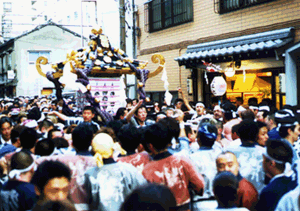
San-no-miya and JIDAIYA shop |
Kisa-ichi for Asakusa, and Asakusa for Kisa-ichi! |
| from 6PM Miyairi or return of the three Miya Mikoshis | |
| The three Miya Mikoshis had returned to Asakusa Shrine and would rest for another year in the storehouse. In contrast to the energetic Miyadashi festivity, only the singing of steeplejacks in low voice and the following sound of ceremonial hand clapping reverberate the night air in the closing ceremony of Miyairi. | |
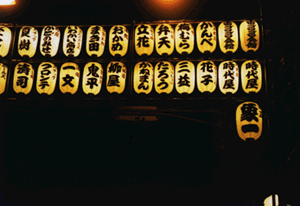
Paper lantern float
A year in Asakusa starts with Sanja Festival.
It plays a large part in lives of people living in Asakusa.
Now it's another year before Sanja Festival and this is the end of our report.
Paper lanterns strung from the eaves,
Sway over Miyado River.
The happi coat shows the high spirit in him.
And he lets it out in Miyadashi fever.
From Ichi-no-miya to San-no-miya,
Are crowds of people so wild and cool.
A tattoo on his arm says "Live or let die",
And I am jealous of Sanja Festival
That he loves so much.
(lyric from kiyomoto)
(By JIDAIYA)

 Go TOP
Go TOP
